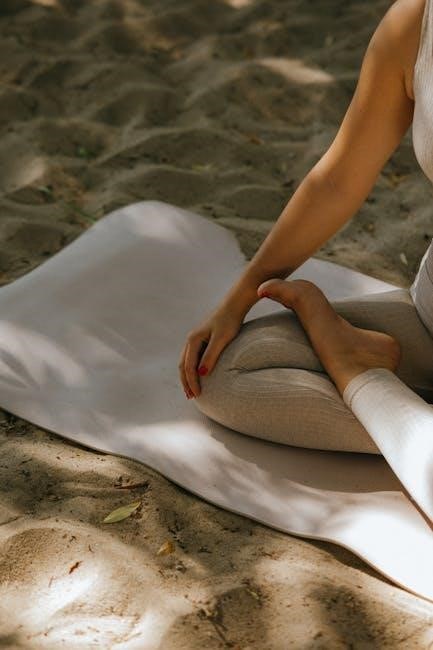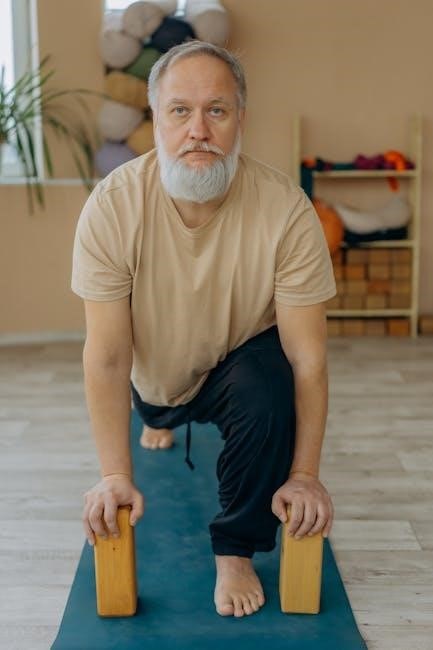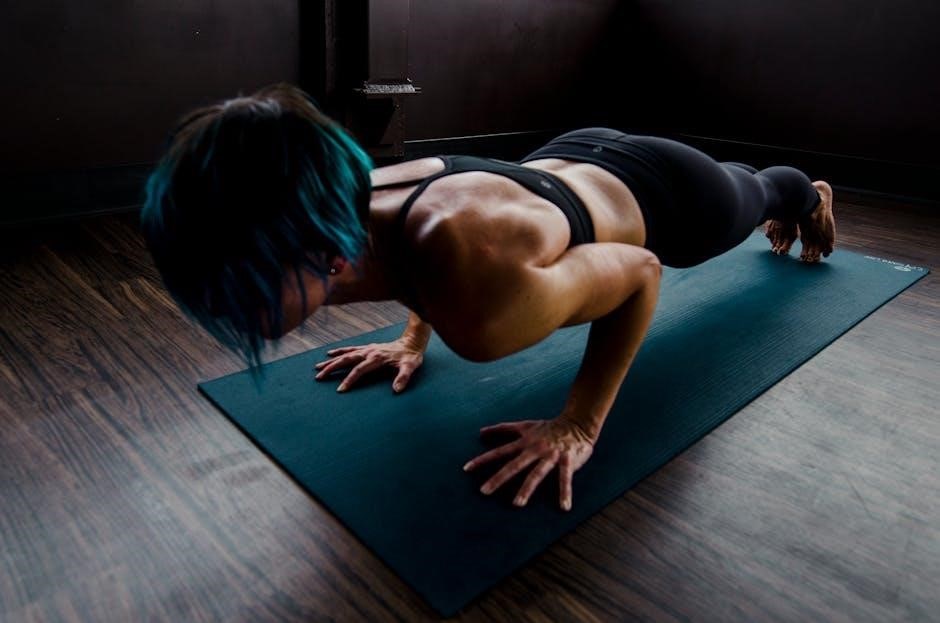yoga for beginners pdf
Yoga is a holistic practice combining physical postures, breathing techniques, and meditation, ideal for beginners seeking flexibility, strength, and mental calm. Perfect for all levels, it offers a transformative journey toward wellness, reducing stress and improving overall health. Explore beginner-friendly poses, sequences, and guides to kickstart your yoga journey with confidence.
What is Yoga and Its Benefits
Yoga is an ancient practice combining physical postures, breathing techniques, and meditation to promote holistic well-being. It enhances flexibility, balance, and strength while reducing stress and improving mental clarity. Ideal for beginners, yoga fosters a connection between body, mind, and spirit. Regular practice can boost energy levels, improve posture, and enhance overall health. Its benefits extend beyond the physical, offering emotional calm and resilience. With accessible poses and modifications, yoga is suitable for all ages and fitness levels, making it a perfect way to embrace a healthier, more balanced lifestyle. Free PDF guides provide step-by-step instructions for beginners.
Why Yoga is Perfect for Beginners
Yoga is an ideal practice for beginners, offering a gentle and adaptable approach to improving physical and mental well-being. It caters to all fitness levels and body types, allowing modifications to suit individual needs. Yoga helps reduce stress, enhance flexibility, and build strength, making it a great way to start a fitness journey. Its holistic nature combines physical postures, breathing techniques, and meditation, promoting overall balance. With free PDF guides and step-by-step instructions available, beginners can easily learn and practice at home, making yoga an accessible and rewarding practice for anyone looking to embrace a healthier lifestyle.
Essential Concepts for Yoga Beginners
Mastering the foundation of yoga involves understanding the Eight Limbs, Yamas, Niyamas, breathing techniques, and basic poses, all of which are elegantly explained in free PDF guides for beginners.
The Eight Limbs of Yoga
The Eight Limbs of Yoga, outlined in Patanjali’s Yoga Sutras, provide a holistic path to living a meaningful and balanced life. They include the Yamas (ethical guidelines like non-violence and truthfulness) and Niyamas (personal observances like cleanliness and self-discipline). Asanas (physical postures), Pranayama (breathing techniques), and Pratyahara (sense withdrawal) form the foundation of a physical and mental practice. Dharana (concentration), Dhyana (meditation), and Samadhi (union with the divine) complete the journey toward self-realization. These limbs guide beginners in cultivating awareness, harmony, and spiritual growth, offering a comprehensive approach to yoga beyond physical poses.
Understanding the Yamas and Niyamas
The Yamas and Niyamas are ethical and moral guidelines that form the foundation of yoga; The five Yamas—Ahimsa (non-violence), Satya (truthfulness), Asteya (non-stealing), Brahmacarya (self-control), and Aparigraha (non-possessiveness)—teach how to interact with the world compassionately. The five Niyamas—Saucha (cleanliness), Santosa (contentment), Tapas (self-discipline), Svadhyaya (self-reflection), and Ishvara Pranidhana (surrender to a higher power)—focus on personal growth and self-awareness. Together, they guide beginners in cultivating a balanced and mindful lifestyle, ensuring yoga is not just a physical practice but a holistic way of living.

Getting Started with Yoga
Begin by setting up a peaceful practice space and selecting the right yoga mat. Start with a 10-minute morning routine, incorporating modifications for a safe and enjoyable experience.
Setting Up Your Home Practice Space
Creating a peaceful and functional home yoga space is essential for a consistent practice. Choose a quiet, spacious area with a non-slip floor. Invest in a high-quality yoga mat for comfort and grip. Consider adding props like blocks, straps, or blankets to support your poses. Ensure good ventilation and a calming ambiance with soft lighting or plants. Minimize distractions by designating this area solely for yoga. Download free PDF guides for setup tips and inspiration. A well-prepared space will help you stay focused and enjoy your practice, fostering a deeper connection to yoga.
Choosing the Right Yoga Mat and Props
Selecting the right yoga mat and props is crucial for a comfortable and effective practice. Opt for a high-quality, non-slip yoga mat that provides excellent grip and cushioning. Eco-friendly and textured mats are ideal for beginners; Props like blocks, straps, and blankets can help modify poses to suit your flexibility and strength levels. They allow you to maintain proper alignment and prevent injuries. Download free PDF guides for recommendations on the best mats and props for your needs. Investing in the right equipment will enhance your practice and ensure a safe, enjoyable experience as you explore yoga.

Basic Yoga Poses for Beginners
Child’s Pose (Balasana)
Child’s Pose is a gentle, resting posture that stretches the back and hips. It’s perfect for relaxation and is often used as a counter-pose in sequences. Suitable for all levels, it promotes calmness and flexibility, making it an excellent choice for beginners to recharge and rejuvenate during practice.
Mountain Pose (Tadasana)
Mountain Pose, or Tadasana, is a foundational standing posture that establishes proper alignment and balance. It serves as the starting point for many yoga sequences and is often considered the “resting pose” between more dynamic movements. To practice Tadasana, stand tall with feet hip-width apart, engage your core, and maintain a neutral spine. Arms rest by your sides, and your gaze is forward. This pose promotes good posture, stability, and awareness. It’s an excellent starting point for beginners, teaching essential alignment principles and preparing the body for more complex poses while fostering a sense of grounding and focus.
Downward Dog (Adho Mukha Svanasana)
Downward Dog, or Adho Mukha Svanasana, is a widely recognized yoga pose that offers a full-body stretch and strengthens the arms, shoulders, and core. To practice, start on all fours, then lift your hips upward, forming an inverted V shape. Keep your palms and heels grounded, engage your arms, and stretch your chest toward your thighs. Modify by bending your knees slightly if your hamstrings feel tight. This pose improves flexibility, balances the body, and prepares you for more dynamic flows. It’s a foundational posture in many yoga routines, promoting strength and openness while enhancing overall alignment and breath awareness.
Child’s Pose (Balasana)
Child’s Pose, or Balasana, is a gentle, restorative yoga pose perfect for relaxation and stretching the back. Kneel on your mat, then sit back onto your heels. Stretch your arms forward, lower your forehead to the ground, and breathe deeply. This pose is excellent for beginners, providing a calming effect and relieving tension in the neck and shoulders. It can be modified by spreading the knees wide or placing a pillow under the forehead for added comfort. Balasana is often used as a counter-pose between more intense stretches, making it a foundational and rejuvenating part of any yoga routine.

Yoga Breathing Techniques
Explore foundational breathing practices like Ujjayi and Nadi Shodhana. These techniques calm the mind, improve focus, and enhance your yoga experience, essential for beginners to master.
Ujjayi Breath (Ocean Breath)
Ujjayi, or Ocean Breath, is a foundational yoga breathing technique. It involves inhaling and exhaling through the nose with a slightly closed throat, creating a soft hissing sound. This breath is calming, helps focus the mind, and regulates the flow of air during asanas. Ideal for beginners, it promotes relaxation, reduces stress, and improves concentration. Regular practice enhances respiratory health and prepares the body for deeper meditative states. Ujjayi Breath is often used during yoga sequences to maintain rhythm and balance, making it a perfect starting point for those new to yoga breathing practices.
Nadi Shodhana (Alternate Nostril Breathing)
Nadi Shodhana, or Alternate Nostril Breathing, is a balancing yoga technique. It involves closing one nostril with the thumb or pinky finger, inhaling through the other, then exhaling through the opposite. This practice harmonizes the breath, calms the nervous system, and prepares the mind for meditation. It helps reduce stress, improve focus, and balance energy. Beginners can start with short rounds, gradually increasing as they grow comfortable. Regular practice enhances respiratory health, promotes relaxation, and aligns the body’s subtle energies, making it a powerful addition to any yoga routine.

Yoga Routine for Beginners
A yoga routine for beginners combines simple postures, breathing techniques, and relaxation to enhance flexibility, strength, and mental clarity. It’s perfect for all levels, promoting stress reduction and overall well-being while building a strong foundation for your practice.
A 10-Minute Morning Yoga Sequence
Start your day with a refreshing 10-minute yoga sequence designed for beginners. Begin with Mountain Pose (Tadasana) to ground yourself, then flow into Downward Dog (Adho Mukha Svanasana) for a full-body stretch. Transition to Child’s Pose (Balasana) to relax and breathe deeply. Move into a Seated Forward Fold (Paschimottanasana) to stretch your hamstrings and spine. End with Cat-Cow Pose (Marjaryasana-Bitilasana) to gently warm up your spine. Hold each pose for 3-5 breaths and repeat the sequence twice. This routine is perfect for energizing your morning and setting a positive tone for the day. A free PDF guide is available for step-by-step instructions and modifications.
Modifications for Common Poses
Modify yoga poses to suit your comfort and flexibility. For Mountain Pose (Tadasana), slightly bend your knees if your hamstrings feel tight. In Downward Dog (Adho Mukha Svanasana), use a block under your hands or bend your knees to reduce pressure. For Child’s Pose (Balasana), place a pillow under your chest for support. These adjustments ensure poses are accessible and safe for beginners. Free PDF guides provide detailed modifications and tips to enhance your practice. By incorporating these tweaks, you can enjoy the benefits of yoga without strain or discomfort.
